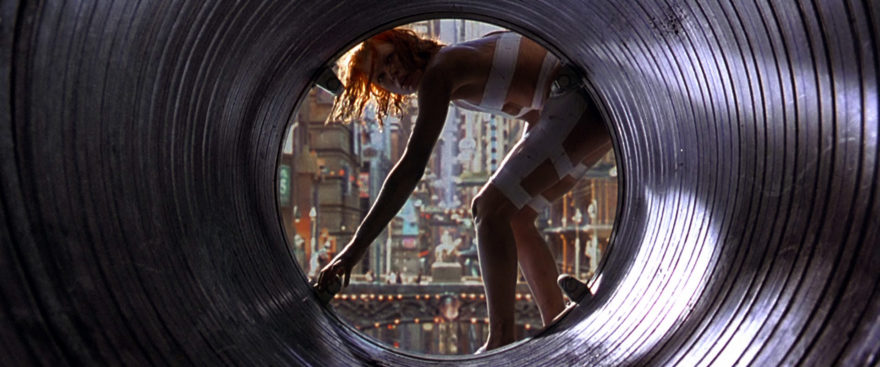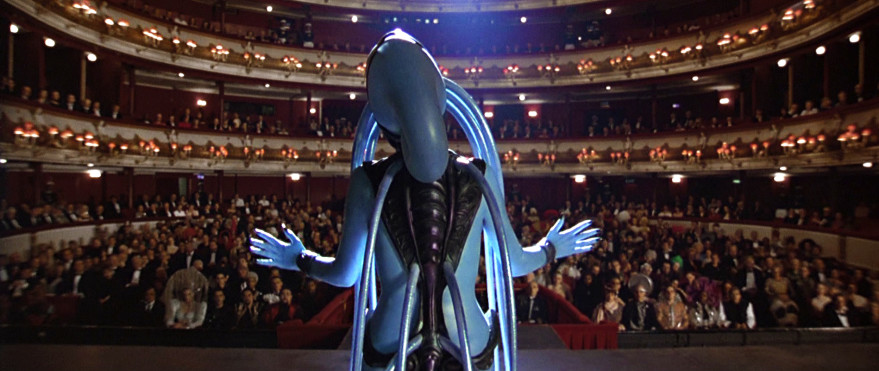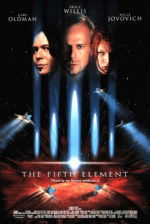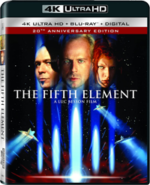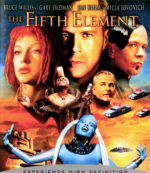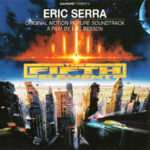The Fifth Element is a wildly entertaining jumble of action, love story, frenetic comedy and alien space opera—all rolled into an adventure that has as many twists and turns as it has aliens and visual effects. Fate drops a vulnerable and powerful woman—a divinely created ‘perfect’ being who controls the fifth element—into the cab of a down-on-his-luck taxi driver and gets him caught up, reluctantly, in her mission to save the Universe from destruction.
The film is overflowing with jaw-dropping visuals, and in one of its most iconic scenes a scantily clad heroine, confused and under attack, finds herself in a future New York City escaping along the ledge of a skyscraper—as flying cars zoom by next to her. Facing the barrel of a police shotgun, and with nowhere else to go, she jumps off the building into the three-dimensional flow of traffic—literally a leap of faith, and a taste of the roller coaster ride to come.
The film jumps freely from comedy to action to drama—and back again. One moment we find our hero trying to hide people in his comically tiny apartment by squeezing them into hide-a-beds and refrigerators, and the next he’s watching a captivating blue alien sing a mesmerizing opera—and all this is set against action-packed shootouts and giant explosions as the forces of good and evil battle over the fate of the Universe.
With The Fifth Element, director Luc Besson created a convoluted and fast-paced film that may well overwhelm at first, but is clearer and more fun on repeat viewings. The film is based on an idea that Besson had as a teenager. To create the sets and design the aliens, he recruited the graphic artists from the French comics of his childhood: Jean-Claude Mézières and Moebius. He also hired one of France’s most famous fashion designers, Jean Paul Gaultier (the man who created Madonna’s famous cone bra) to make almost 1,000 futuristic costumes. Besson even came up with an entire language, ‘Divinian,’ which is spoken by the film’s heroine, actress Milla Jovovich. She practiced this invented language by sending letters written in Divinian to director Luc Besson.
Revered by visual effects artists, The Fifth Element seamlessly brings together miniatures, enormous sets, remote controlled alien costumes, digital effects and old-fashioned movie magic. The model of New York City measured 40-feet wide by 70-feet deep and took 60 people over nine months to build and paint. And the different types of aliens were played by actors with specific physical characteristics: the dog-like ‘Mangalores’ were played by body-builders who had sloping foreheads so the prosthetic alien heads would fit them, and the metal-clad ‘Mondoshawans’ were actually 6-foot 9-inch tall actors encased in full body costumes. They could not see where they were walking, so cameras and monitors were installed inside their costumes to keep them from tumbling off the set.
When it was made, the $90 million price tag made The Fifth Element the most expensive movie that had ever been produced in France. It was the opening film for the 1997 Cannes film festival and held the record as France’s most successful international export for 16 years, raking in $264 million in worldwide box office earnings. Given a ‘thumbs up’ by Roger Ebert and Gene Siskel and nominated for nearly two dozen major awards, The Fifth Element was also named one of the fifty most influential films of all time by the Visual Effects Society.
Enjoying the site? If so consider supporting it with alien-infused caffeine…


